Frozen Dragon Eggs Ice Melting Science
Kids will love this sensory science idea. Use our frozen dragon eggs activity to explore ice melting science. Once the dragons are free from the ice eggs, play with them in the colored water. I get commissions for purchases made through the affiliate links in this post.
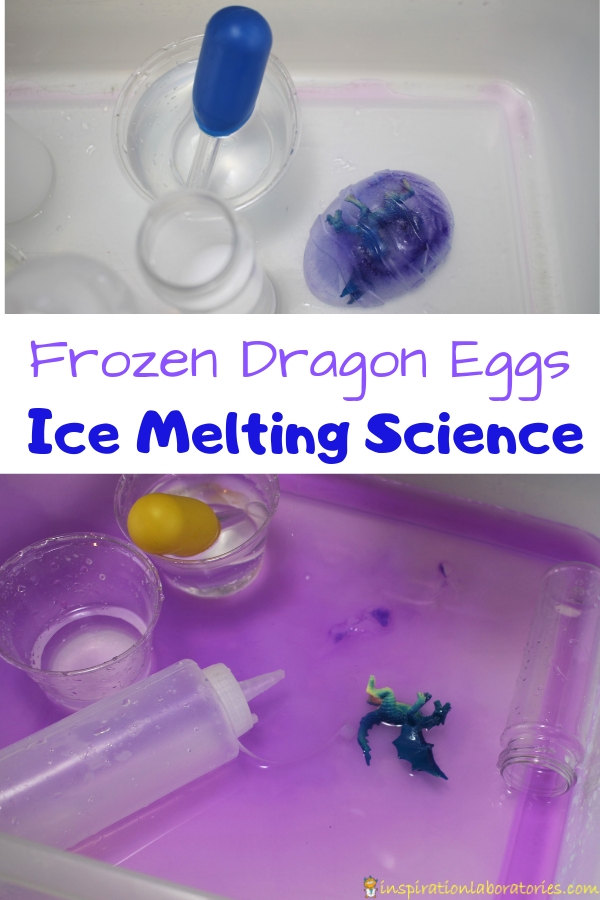
Frozen Dragon Eggs Ice Melting Science
Trapping toys in ice and rescuing them is a classic science experiment that every kid has to try. Aiden (my oldest) has always loved freezing LEGO bricks and minifigures. I was planning an activity for Lily’s preschool class and I asked her what she wanted to do. She remembered rescuing dragons from ice during Asia Citro’s author visit at the library last year. The first book in Asia’s Zoey and Sassafras series is Dragons and Marshmallows hence the dragons. In Caterflies and Ice, Zoey is tasked with rescuing caterfly eggs that have been trapped behind some ice. She uses science and experimentation to try to solve the problem.
Supplies Needed for the Frozen Dragon Eggs
- Silicone egg mold
- Dragon toys
- Water for egg mold
- Washable liquid watercolors (optional)
- Container for conducting the activity (baking dish, storage container, large bowl, etc.)
- Jumbo droppers, pipettes, squeeze bottles (or just use a cup)
- Cups/container for holding water
- Salt
- Warm water
How to Set Up the Dragon Ice Rescue
We set up our own dragon rescue. I placed the dragons in the egg molds and covered them with colored water. (I used washable liquid watercolors. You could also use food coloring but be warned that food coloring can stain clothes and some surfaces. Also it takes longer to wear off of your skin.) Into the freezer they went.
Helpful tip: use a small baking dish or rectangular tray/plate to hold the egg mold. The silicone mold is a bit flimsy. A hard surface underneath makes it much easier to transfer to the freezer.
Once the dragons are frozen in ice, it’s time to play. I did this activity with 11 preschoolers so I used large storage bins that would give room for 4 children to do the activity in each bin.
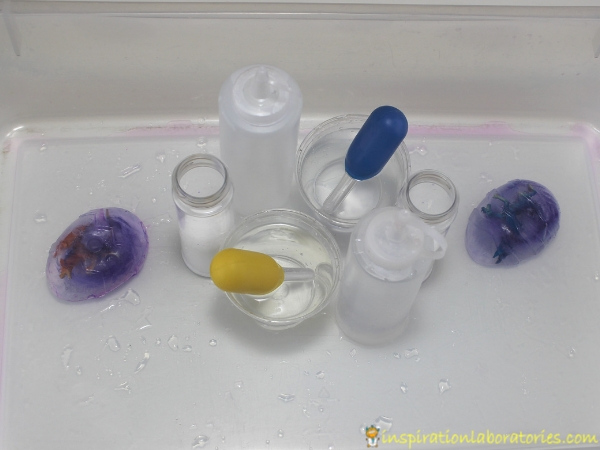
Each bin gets warm water. (Cold water works, too. I used warm water to make the water at the end more pleasant to play with.) Place the warm water in cups or bowls and add droppers or place the warm water in squeeze bottles. For my groups I set out two droppers with cups of water and two squirt bottles. Alternatively you could just set out cups of warm water for kids to pour. You’ll need to refill the water more often. Squeezing droppers or bottles adds a bit of find motor practice and hand strengthening. Plus it slows the activity down and lets your kids explore the ice more.
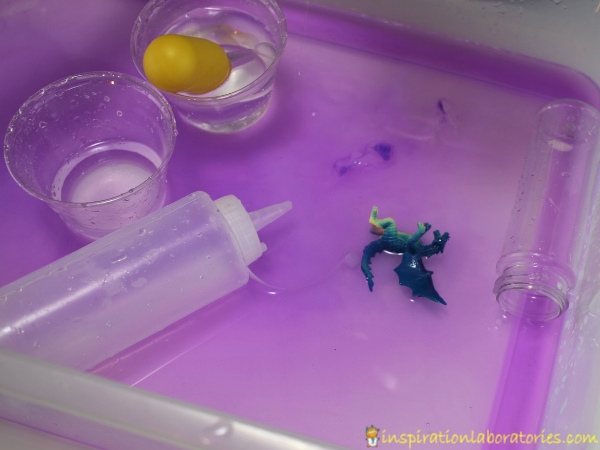
Salt is another great addition to this activity. You can totally skip it if you want, but it helps the ice melt faster and leads to discussions about why we use salt on the roads in winter. Salt lowers the freezing point of water. This means that water freezes at a lower temperature when salt is added. It will be liquid instead of solid at a colder temperature.
I gave each child about two tablespoons of salt in a plastic test tube. We have a bunch of HEXBUG nano tubes left over from our robot party. You could use a small cup or spice container. In the video, I used sprinkle containers.
How to Introduce the Dragon Ice Melting Science Activity
I started by telling the kids we had dragons frozen in ice eggs. It was their job to help rescue the dragons and free them from the ice. I asked them what we needed to do. They said we needed to melt the ice. I told them there were two ways we could do that. We could use salt or we could use warm water.
I told the kids they could use however much salt they wanted. Some started with a small amount, but most of them ended up using all of the salt given to them. Lily (age 5) and Elon (age 3) chose to pour the whole lot of it on their dragon eggs.
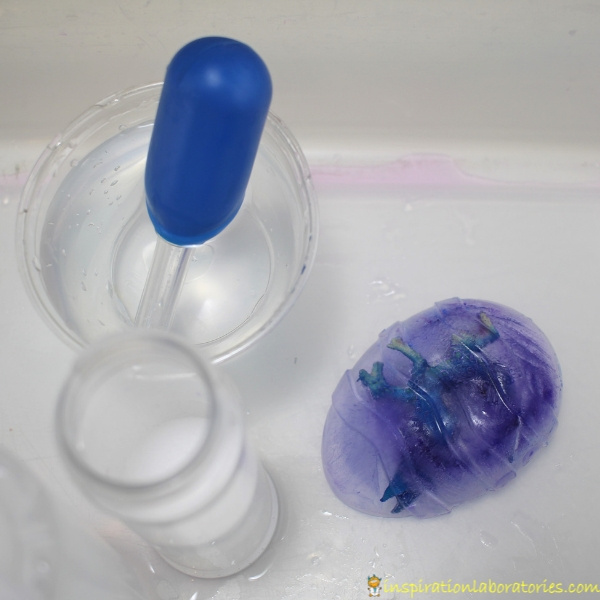
I showed the kids how to use the droppers as some had never used them before. I told them they could take turns using the droppers and squeeze bottles so everyone could try both.
They added salt and warm water to the eggs until the dragons were free.
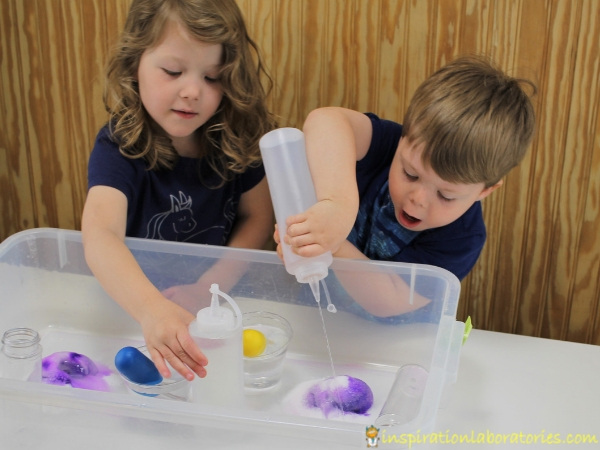
Then they continued to play in the water. This is the main reason I used warm water. Using cold water will make the melted ice too cold to play with for very long. Using warm water (think kid’s bathwater warm) results in a nice cool water to play with.
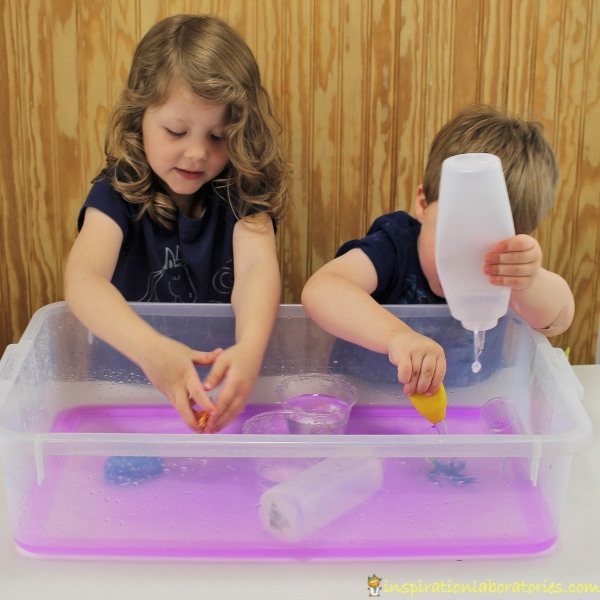
More Dragon Themed Activities for Kids
- Dragon Sensory Writing Tray
- Color Changing Dragon Egg Hunt
- Unicorn and Dragon Rainbow Sensory Bin
- Favorite Dragon Books for Kids
Subscribe to the Inspiration Laboratories newsletter. Each issue has exclusive hands-on science explorations for children, a recap of our latest activities, and special resources selected just for you!

Leave a Reply